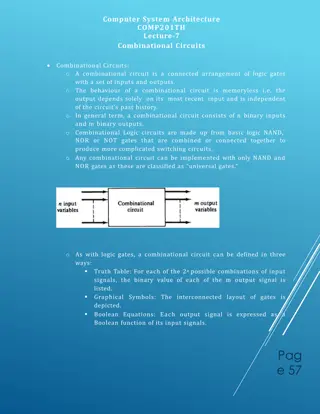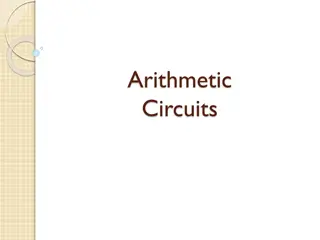Understanding 4-Bit Parallel Adder/Subtractor IC7483
Explore the concept of 4-bit parallel adder/subtractor using IC7483, which is a digital circuit capable of performing arithmetic operations on binary numbers greater than one bit in length. Learn about the structure, operation, and implementation of parallel adders with cascaded full adders. Discove
8 views • 11 slides
Computer Architecture: Arithmetic Algorithms and Memory Address Mapping
Exploring the intricate world of computer architecture, this study delves into the realms of signed-magnitude addition and subtraction, multiplication operations, and memory address mapping for microprocessors. It uncovers the hardware components involved in these operations, such as registers, flip
1 views • 24 slides
Understanding Combinational Circuits in Computer Architecture
Combinational circuits in computer architecture play a crucial role in transforming binary information from input data to output data. These circuits consist of logic gates connected in a specific arrangement to process binary data efficiently. Key components such as half-adders and full-adders are
1 views • 48 slides
Year 8 Mathematics Checkpoint Activities: Sequences & More
Dive into the diagnostic mathematics activities aimed at Year 8 students, focusing on sequences. The publication includes twenty-two Checkpoint activities with additional exercises, covering topics like adders, counting counters, same jump comparisons, and multiples. Explore the underpinnings of mat
0 views • 51 slides
Understanding Combinational Circuits in Digital Systems
Combinational circuits in digital systems consist of logic gates interconnected to process input signals and produce output based solely on the current input, without any memory. They are implemented using basic logic gates like NAND, NOR, or NOT gates, which can be combined to create complex switch
0 views • 5 slides
Understanding Digital Logic Design Fundamentals
Delve into the intricate world of digital logic design with a focus on components like binary adders, subtracters, and comparators. Explore the concept of scale of integration and learn about MSI components and the realization of full binary adders. Discover how to simplify circuits and grapple with
0 views • 32 slides
Understanding Combinational Circuits in Computer Science
Explore the fundamentals of combinational circuits in computer science, including adders, subtractors, half adders, and full adders. Learn about circuit design, optimization, and manipulation of equations to enhance computational efficiency.
0 views • 25 slides
Insights from Multi-Day Forecast Long Lead Time Survey Results
Southwest Power Pool (SPP) conducted a survey to assess the impact of a multi-day commitment process on long lead-time resources. Results showed varying preferences among members for different commitment statuses, with considerations for market, self, and reliability commitments. Environmental restr
0 views • 19 slides
Energy-Efficient GPU Design with Spatio-Temporal Shared-Thread Speculative Adders
Explore the significance of GPUs in modern systems, with emphasis on their widespread adoption and performance improvements over the years. The focus is on the need for low-power adders in GPUs due to high arithmetic intensity in GPU workloads.
0 views • 46 slides
Understanding Combinational Circuits in Computer Architecture
A combinational circuit consists of logic gates that transform binary input data into output data based on the input combination. This chapter covers the design and functionality of half-adders and full-adders, essential components in digital systems. Through truth tables, Boolean functions, and log
0 views • 15 slides
Understanding Full Adders and Subtractors in Digital Circuits
Exploring the implementation of 1-bit full adders and subtractors, including truth tables, Boolean expressions, and concepts like carry propagation and prefix adders. Dive into the intricacies of column generation, propagation, and computation in different types of adders for efficient arithmetic op
0 views • 22 slides
Understanding Combinational Circuits in Digital Electronics
Combinational circuits are an essential component of digital electronics, combining different gates to perform specific functions without memory usage. They provide outputs based solely on present input levels, with no influence from previous states. Types of combinational circuits include half adde
0 views • 55 slides
Understanding Carry Look-Ahead Adders in Digital Systems
Explore the concept of Carry Look-Ahead Adders in digital system fundamentals. Learn how to optimize the carry chain, implement Partial Full Adders, and enhance speed by flattening carry logic. Dive into the mathematics behind Ripple-Carry Adders and Carry Look-Ahead Adders, unraveling multi-level f
0 views • 14 slides
Understanding ALUs and Adders in Computer Architecture
Explore the concepts of Arithmetic Logic Units (ALUs) and adders in computer systems through topics like ALU operations, 1-bit ALU with Add, Or, And operations, 32-bit Ripple Carry Adder, subtraction incorporation, NOR and NAND operations, control lines for different operations, incorporating slt an
0 views • 19 slides
Understanding Binary Addition Circuits in Computing
Explore the concepts of half adders, full adders, and binary addition circuits used in computer systems. Learn how binary digits are represented as logic levels to perform addition operations. Dive into the working principles of half adders, truth tables, formulas, and circuit diagrams for binary ad
0 views • 15 slides
Understanding Half Adders and Full Adders in Combinational Logic Circuits
Half adders and full adders are essential components in combinational logic circuits for performing addition operations on binary numbers. While half adders can add two single-bit numbers but do not consider carry bits, full adders can handle three bits with carry input. Understanding the input and
0 views • 9 slides
Understanding Computer Arithmetic Basics: Addition, Multiplication, Division, and More
Delve into the fundamentals of computer arithmetic with concepts such as adding 1-bit numbers, half adders, full adders, equations, circuits, and the addition of n-bit numbers. Explore the intricacies of binary arithmetic operations and learn how computers perform calculations effectively.
0 views • 84 slides
Understanding Standard Combinational Modules in Digital Design
Introduction to standard combinational modules such as decoders, encoders, multiplexers (Mux), demultiplexers (DeMux), shifters, adders, and multipliers. Exploring their behaviors, logic, and applications in signal transport, data processing, and address manipulation. Detailed explanation of how dec
0 views • 26 slides
Land Use Policy Evolution in Massachusetts Solar Incentive Programs
Evolution of land use policy in Massachusetts solar incentive programs, focusing on Solar Carve-out I and II programs, Solar Massachusetts Renewable Target Program (SMART), and SMART Land Use Policy Incentives. Discusses location-based adders, disincentives, and adder values for various categories o
0 views • 9 slides
Trade-offs in Floating Point Accumulation: Balancing Accuracy, Cost, and Performance
When designing floating point accumulation systems, achieving high throughput and accuracy presents a challenging trade-off. Inconsistent accuracy due to data dependencies can lead to significant errors in results. Strategies such as compensated summation or using extended precision adders can help
0 views • 11 slides



















